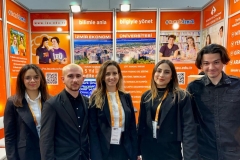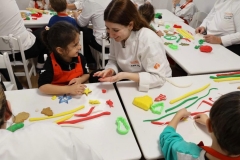
SCHOOL OF APPLIED MANAGEMENT SCIENCES
Gastronomy and Culinary Arts Program
GEAR 214 | Course Introduction and Application Information
| Course Name |
Presentation Skills in Communication
|
|
Code
|
Semester
|
Theory
(hour/week) |
Application/Lab
(hour/week) |
Local Credits
|
ECTS
|
|
GEAR 214
|
Fall/Spring
|
1
|
2
|
3
|
4
|
| Prerequisites |
None
|
|||||
| Course Language | ||||||
| Course Type |
Second Foreign Language
|
|||||
| Course Level |
-
|
|||||
| Mode of Delivery | - | |||||
| Teaching Methods and Techniques of the Course | - | |||||
| Course Coordinator | - | |||||
| Course Lecturer(s) | ||||||
| Assistant(s) | - | |||||
| Course Objectives | This course aims to improve in students two very important and desirable skills in interpersonal communication: (1) Communicating effectively and efficiently using audio-visual media; (2) Persuading the audience into complying with the aim of the presentation / presenter. |
| Learning Outcomes |
The students who succeeded in this course;
|
| Course Description | This course aims to equip the students with the fifth language proficiency skill: Sharing information through effective presentations (the original four were: Listening, Speaking, Reading, Writing) It aims to create awareness regarding the importance of interpersonal communication skills and does this through both theory and practice. |
|
|
Core Courses | |
| Major Area Courses | ||
| Supportive Courses | ||
| Media and Management Skills Courses | ||
| Transferable Skill Courses |
WEEKLY SUBJECTS AND RELATED PREPARATION STUDIES
| Week | Subjects | Related Preparation |
| 1 | Introduction of Lecture Sources and Software Explanation of the general design and approach of the course. First exposure to the process of communication, past and present. | Just come to class with an open mind. |
| 2 | Weekly subjects, presentations skills, verbal / non-verbal communication Non-verbal communication in more detail | Course Book: Business Communication Today, Bovée, Courtland, & Thill, John V., 12th Edition, 2014, Prentice Hall, |
| 3 | Warm up: Why you need presentation skills, importance of communication in business, FAQ / Q&A, The meaning of effective communication | Chapter 1 (pp 40 – 68) |
| 4 | 5W1H approach to successful communication Secrets of successful orators | Chapter 4 (pp 123 – 148) |
| 5 | Express your feelings through role-play Sample presentations | Chapter 5 (pp 152 – 177) |
| 6 | What to present: Content, idea, tip Idea generation techniques: Story-teller's tour, Brain-storming, Utilizing field sources, et al. | Chapter 6 (pp 182 – 206) |
| 7 | Persuasive messages: AIDA as the road plan Sample presentations | Chapter 12 |
| 8 | How to find and process information Secondary sources Primary sources How to present words, typography, visuals, symbols, fonts and other written characters, use of colors | Chapter 7, 8, 9 summary; Short review of Chapter 6 Steve Jobs in Apple videos |
| 9 | How to write a manuscript format report as a basis for the presentation | Chapters 14 and 15 (pp 437 – 494) |
| 10 | How to prepare a professional presentation | Chapters 16 and 17 (pp 506 – 552) |
| 11 | MIDTERM EXAM | |
| 12 | Student Presentations | |
| 13 | Student Presentations | |
| 14 | Student Presentations | |
| 15 | Review of the semester | |
| 16 | Final Project |
| Course Notes/Textbooks | Course Book: Business Communication Today, Bovée, Courtland, & Thill, John V., 12th Edition, 2014, Prentice Hall, |
| Suggested Readings/Materials | A long list to be presented by the Lecturer on the opening day TED talks Videos to be supplied by the Lecturer |
EVALUATION SYSTEM
| Semester Activities | Number | Weigthing |
| Participation |
1
|
15
|
| Laboratory / Application | ||
| Field Work | ||
| Quizzes / Studio Critiques |
1
|
5
|
| Portfolio | ||
| Homework / Assignments |
1
|
10
|
| Presentation / Jury |
2
|
40
|
| Project | ||
| Seminar / Workshop | ||
| Oral Exams | ||
| Midterm |
1
|
30
|
| Final Exam | ||
| Total |
| Weighting of Semester Activities on the Final Grade | ||
| Weighting of End-of-Semester Activities on the Final Grade | ||
| Total |
ECTS / WORKLOAD TABLE
| Semester Activities | Number | Duration (Hours) | Workload |
|---|---|---|---|
| Theoretical Course Hours (Including exam week: 16 x total hours) |
16
|
3
|
48
|
| Laboratory / Application Hours (Including exam week: '.16.' x total hours) |
16
|
0
|
|
| Study Hours Out of Class |
0
|
||
| Field Work |
0
|
||
| Quizzes / Studio Critiques |
1
|
12
|
12
|
| Portfolio |
0
|
||
| Homework / Assignments |
1
|
20
|
20
|
| Presentation / Jury |
2
|
25
|
50
|
| Project |
0
|
||
| Seminar / Workshop |
0
|
||
| Oral Exam |
0
|
||
| Midterms |
1
|
30
|
30
|
| Final Exam |
0
|
||
| Total |
160
|
COURSE LEARNING OUTCOMES AND PROGRAM QUALIFICATIONS RELATIONSHIP
|
#
|
Program Competencies/Outcomes |
* Contribution Level
|
||||
|
1
|
2
|
3
|
4
|
5
|
||
| 1 | Successfully applies theoretical and practical knowledge and skills in Gastronomy and Culinary Arts |
|||||
| 2 | Carries best practices in terms of work and food security, safety and hygiene in food production |
|||||
| 3 | Appreciates, evaluates and makes decisions regarding to visual, textual and nutritional data with respect to food production and presentation |
|||||
| 4 | Recognizes and evaluates the impact of gastronomy on culture and society |
|||||
| 5 | Assumes responsibility for solving complex problems that may occur in the field of Gastronomy and Culinary Arts, both individually and as a team member |
|||||
| 6 | Evaluates the knowledge and skills acquired in the field of Gastronomy and Culinary Arts with a critical approach and effectively communicate their ideas and suggestions for solutions in written and oral form. |
|||||
| 7 | Possesses necessary knowledge and skills in relevant fields such as gastronomy, design, law and management and effectively apply them to the practice of Culinary Arts |
|||||
| 8 | Uses the technological tools related to Gastronomy and Culinary Arts effectively |
|||||
| 9 | Updates and improve the knowledge, skills and competencies related to Gastronomy and Culinary Arts with lifelong learning awareness and sustainability with an ethical approach |
|||||
| 10 | Collects data in the areas of Gastronomy and Culinary Arts and communicate with colleagues in a foreign language. (European Language Portfolio Global Scale”, Level B1) |
|||||
| 11 | Speaks a second foreign at a medium level of fluency efficiently |
|||||
| 12 | Relates the knowledge gained through the history of humanity to the field of expertise |
|||||
*1 Lowest, 2 Low, 3 Average, 4 High, 5 Highest
NEWS |ALL NEWS
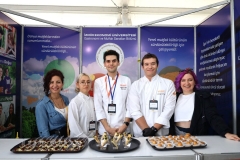
Aegean flavors from the chefs of the future
Izmir University of Economics (IUE) Department of Gastronomy and Culinary Arts left its mark on the 6th Izmir GastroFest, organized this year with
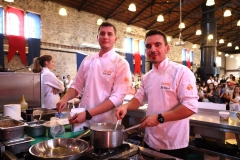
They added flavor to GURMEFEST
GURMEFEST, one of the biggest food, drink and entertainment festivals of Izmir, was ‘flavored’ with the dishes prepared and presented by the
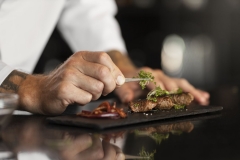
“Izmir and Bodrum will class up”
The MICHELIN Guide, one of the most prestigious restaurant rating systems in the world, has added Izmir and Bodrum to its Turkish
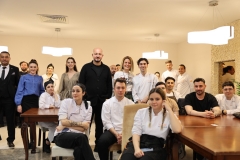
IUE graduates will prepare the flavors unique to Turkish cuisine
Bilsev Group, who is preparing to expand to Dubai this year with its Ferdi Baba, Fabrice Restaurant and Baba Pizza brands, will

They prepared products that are filling and have a long shelf life
25 students of Department of Gastronomy and Culinary Arts of Izmir University of Economics (IUE) prepared products with a long shelf life,



